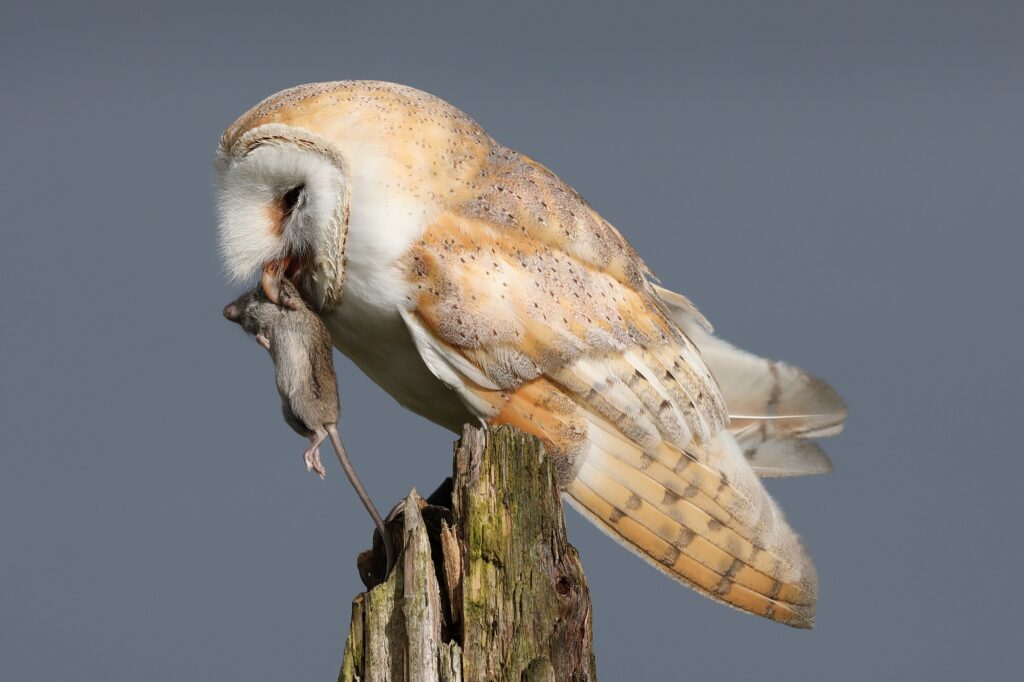Rebuilding habitats for natural rodent control
The following article was originally posted in Wine Business Monthly in April of 2022.
Did you know that owls are cannibalistic? Baby owls will feast on their owlet-siblings to reduce competition. Did you know that owls strike so fast they kill on contact? It’s the equivalent of getting hit with a truck…a truck with talons.
I love talking to bird people. They’re such sadists. Or rather, they look at the grim brutality of the natural world and dive right in. They’re the ones who root for the T-Rex in Jurassic Park. In Don’t Look Up, they’re most likely rooting for the asteroid.
So, when it comes to rodent control, a topic most people find icky, who better to consult than someone passionate about birds? Recently, I had the opportunity to sit down with John Schuster of Wild Wing Company in Sonoma County, Calif.
Schuster has had a fascinating career in forestry, firefighting and conservation. He also makes most of the owl boxes I see in the North Coast. It turns out if you ply him with a cappuccino, he’ll tell you all sorts of things about owls and how they benefit farmers.
What Is an Owl Box and What Is it Used for?
Owls are a cavity dwelling bird species. They eat a lot of nocturnal rodents, such as voles and pocket gophers. An adult owl requires on average 156 grams of food each night: that’s about the size of one gopher or two voles—double that if he’s got a mate back home. Baby owls require three to five times this per night, and a typical brood is between three to five owlets. If you have an owl box with a little owl family in it, you’re looking at 3 kilograms (about 6.5 pounds) of rodents per night.
The goal of your natural predation program should be this: establish a healthy population of breeders. Predators follow prey; so, if you have a high population of rodents, that should be enough to sustain many families of breeding owls. Owl families will consume many more gophers and voles than your bachelor birds. Owls won’t even mate unless there’s enough food on the table to support offspring. I know many farmers who have more than enough gopher meat to go around.
It’s always important to remember that the vineyard is far from a natural place. Under untouched conditions, owls would be able to find homes in tree hollows and the like. That kind of real estate isn’t as available among acres and acres of vines and trellis hardware. If your rodent population has blown up, it’s probably linked to habitat loss of native predators. Owl boxes allow for the reestablishment of what’s been lost. For some of you, that is reason enough to put some of these in. However, not all owl boxes are created equal.

Owl House in the Middle of Owl Street: What Makes a Good Owl Box?
To build a good owl box, one must first become the owl…or at least consult someone like John Schuster, who’s made it his life’s work.
To begin with, owls are sensitive to heat. For this reason, it is imperative to face the opening of your owl boxes eastward: not magnetic East but true East. Wild Wing’s owl boxes are built with sun shields on both the roof and the westward wall to keep the cavity from getting too hot.
There are ways you can tell if you’ve created the right kind of cavity environment for owls. Bluebirds, for instance, have very similar residential tastes to owls, as does the Northern Flicker and the ubiquitous European Starling. If you see any of these birds in your box, you know you’re on your way. You will want to clean these other species out first, but hopefully, your next denizens will be of the owl variety. Wild Wing’s boxes have convenient trap doors at the back to accomplish this.
Other birds may be bad roommates, but they are not the only creatures you’ll want to keep out of your owl boxes. Raccoons and opossums prey on owlets and owl eggs. I’ve seen plenty of owl boxes with little lattices to facilitate entering and exiting the cavity; however, owls don’t need those. Raccoons do. It’s much better to have a smooth exterior surface that nothing can cling onto as it snacks on your owls. The same goes for how you mount the owl box. It’s best to use a smooth metal pole rather than a wooden one. Don’t put an owl box in a tree, either. According to John, that’s the biggest mistake people make. Anything that can climb a tree will be able to enter.
When an owl leaves the front door, it always hooks to the right. Isn’t that weird? According to John, this is just their well-documented behavior. If an owl flies out of an eastern-facing door, it will fly southeast and find a perch there. This could be a tree or, in the case of a vineyard, a raptor perch. You will want to ensure your owls have something like this installed at the southwest of your box for the owls to hunt from. The good thing is that these perches can serve double duty by being shared with diurnal hunters, such as hawks and falcons. You can also consider installing one of these at the top of your owl box. Sleeping owls are not bothered by raptors on the roof.

Owl City: Location and Density
Owls will hunt within about a mile and a half radius from their home. Barn owls and Screech owls are not territorial, so there’s no problem having considerable overlap in hunting grounds. John says it’s best to have an owl box every 100 to 200 yards if the rodent population is moderate, with owl boxes every 60 yards if you want to take a more aggressive approach. That seems like a lot to me; but if you are planning on relying exclusively on owl boxes for gopher and vole control, you will want to build a healthy population.
As far as location goes, most owl boxes I see are on the borders of vineyards. This is fine as long as they are not too close to riparian areas that host Great Horned owls. These apex predators will make a meal out of your beneficial owls. Hence Barn and Screech owls steer clear of owl boxes in Great Horned owl neighborhoods. You will know you have Great Horned owls in the area if you hear hooting during the night. Barn owls don’t hoot, but rather make a screeching, hissing or clicking sound.
Most farmers avoid putting owl boxes in the vineyard row. In reality, owls are unbothered by daytime tractor noises or vibration. If you want to avoid wooded areas, putting the box in the middle of the vineyard is better. The only vineyard operation obstructed by owl boxes is mechanical harvesting.
Aside from that, owl droppings are caustic. You won’t want to keep your owls too close to wherever you park your tractor or other vehicles. Droppings (pellets) can also contain rodent fur and bones, which can spread disease, such as Hantavirus. Owls are great but keep them at a distance.

Are Owls All You Need?
An owl can eat plenty of gophers and voles. There’s no argument there. But can farmers rely on them exclusively to control rodent pests? Unfortunately, there’s not a lot of concrete studies that have been done on the topic, and the research that has been done won’t necessarily translate across crops and regions. In Malaysia, for instance, there’s been a few projects that looked at how owls can be used to control rat populations in palm oil fields. Even there, results varied and depended on which rodent posed the greatest threat and how high the population was.[1]
When you’re reintroducing Barn owls into your vineyard, you’re playing with a delicate balance. If you have a high population of gophers and voles, the new birds on the block will gladly dig in. If you follow up with conventional means of rodent control, your owl population may crash soon after due to dwindling food sources. There’s not much research on combined methods of rodent control, which frankly are what most people use.
I know farmers well enough to realize that it all boils down to cost. One of the few studies on this is from Professor Matthew Johnson at Humboldt State University[2]. Johnson compared the use of owl boxes to conventional trapping and strychnine application for pocket gopher control. In 2012 he concluded that the cost of extermination was $0.34 per gopher via owl and $8.11 per gopher via traps. Johnson was not able to calculate the per-gopher cost via poison as most deaths from poison baits occurred underground. While he calculated that a year of rodenticide application was double that of establishing a Barn owl program, poison may very well be more effective.
To be clear, I don’t recommend using rodenticide. If you’re trying to bolster the population of your natural predators, using poison is shooting yourself in the foot.
Conclusion
If you have the bandwidth, I encourage anyone to experiment with natural means of rodent control. Owl boxes are only a piece of the puzzle. Raptor perches can help with ground squirrels, and songbird boxes can be used for insect pests. We kicked out the birds when we developed the vineyard. That’s why there are so many pests, like gophers, voles and ground squirrels. Why not welcome them back into your vineyard. If you build them, they will come.
[1] Kross, S.M. and Baldwin, R.A. (2016). Gopherbusters? A review of the candidacy of Barn Owls as the ultimate natural pest control option. In Proceedings of the Vertebrate Pest Conference (Vol. 27, No. 27).
[2] Wendt, C.A. and Johnson, M.D. (2017). Multi-scale analysis of barn owl nest box selection on Napa Valley vineyards. Agriculture, Ecosystems & Environment, 247, 75-83.
Photos 1 and 2 photo credited to John Schuster of the Wild Wing Company.


